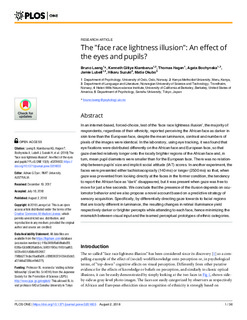| dc.contributor.author | Laeng, Bruno | |
| dc.contributor.author | Kiambarua, Kenneth Gitiye | |
| dc.contributor.author | Hagen, Thomas | |
| dc.contributor.author | Bochynska, Agata | |
| dc.contributor.author | Lubell, James | |
| dc.contributor.author | Suzuki, Hikaru | |
| dc.contributor.author | Okubo, Matia | |
| dc.date.accessioned | 2019-09-02T12:30:25Z | |
| dc.date.available | 2019-09-02T12:30:25Z | |
| dc.date.created | 2018-08-02T20:29:58Z | |
| dc.date.issued | 2018 | |
| dc.identifier.citation | PLoS ONE. 2018, 13:e0201603 (8), 1-36. | nb_NO |
| dc.identifier.issn | 1932-6203 | |
| dc.identifier.uri | http://hdl.handle.net/11250/2612033 | |
| dc.description.abstract | In an internet-based, forced-choice, test of the ‘face race lightness illusion’, the majority of respondents, regardless of their ethnicity, reported perceiving the African face as darker in skin tone than the European face, despite the mean luminance, contrast and numbers of pixels of the images were identical. In the laboratory, using eye tracking, it was found that eye fixations were distributed differently on the African face and European face, so that gaze dwelled relatively longer onto the locally brighter regions of the African face and, in turn, mean pupil diameters were smaller than for the European face. There was no relationship between pupils’ size and implicit social attitude (IAT) scores. In another experiment, the faces were presented either tachistoscopically (140 ms) or longer (2500 ms) so that, when gaze was prevented from looking directly at the faces in the former condition, the tendency to report the African face as “dark” disappeared, but it was present when gaze was free to move for just a few seconds. We conclude that the presence of the illusion depends on oculomotor behavior and we also propose a novel account based on a predictive strategy of sensory acquisition. Specifically, by differentially directing gaze towards to facial regions that are locally different in luminance, the resulting changes in retinal illuminance yield respectively darker or brighter percepts while attending to each face, hence minimizing the mismatch between visual input and the learned perceptual prototypes of ethnic categories. | nb_NO |
| dc.language.iso | eng | nb_NO |
| dc.publisher | Public Library of Science | nb_NO |
| dc.rights | Navngivelse 4.0 Internasjonal | * |
| dc.rights.uri | http://creativecommons.org/licenses/by/4.0/deed.no | * |
| dc.title | The "face race lightness illusion": An effect of the eyes and pupils? | nb_NO |
| dc.type | Journal article | nb_NO |
| dc.type | Peer reviewed | nb_NO |
| dc.description.version | publishedVersion | nb_NO |
| dc.source.pagenumber | 1-36 | nb_NO |
| dc.source.volume | 13:e0201603 | nb_NO |
| dc.source.journal | PLoS ONE | nb_NO |
| dc.source.issue | 8 | nb_NO |
| dc.identifier.doi | 10.1371/journal.pone.0201603 | |
| dc.identifier.cristin | 1599544 | |
| dc.description.localcode | Copyright: © 2018 Laeng et al. This is an open access article distributed under the terms of the Creative Commons Attribution License, which permits unrestricted use, distribution, and reproduction in any medium, provided the original author and source are credited. | nb_NO |
| cristin.unitcode | 194,62,60,0 | |
| cristin.unitname | Institutt for språk og litteratur | |
| cristin.ispublished | true | |
| cristin.fulltext | original | |
| cristin.qualitycode | 1 | |

